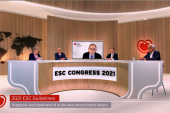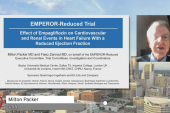Journal of Cardiac Failure Launches Rapid Publication Platform to Spark Discourse
The inaugural paper for JCF Ignite! asks a provocative question: why are digoxin and the SGLT2 inhibitors seen so differently?

To speed the time it takes to get key data and opinions into the medical literature, and to also get people talking, the Journal of Cardiac Failure has a created a new section called JCF Ignite!, which will be home to short, focused papers that are peer-reviewed and published with a quick turnaround.
The first paper in the section, published online last week, poses a provocative question: with similar performance in trials of patients with heart failure and reduced ejection fraction (HFrEF), why are digoxin and the sodium-glucose cotransporter 2 (SGLT2) inhibitors considered so differently in practice guidelines, with much-stronger recommendations for use of the newer agents?
That question, raised by Milton Packer, MD (Baylor Heart and Vascular Institute, Dallas, TX), and Faiez Zannad, MD (Université de Lorraine, Nancy, France), two of six senior reviewers for JCF Ignite!, is sure to spark discussion. But for Packer, the bigger story is the availability of the publication platform itself.
The traditional process of getting new research findings peer-reviewed and published is onerous and slow-moving, and oftentimes, Packer said, a full-length paper will contain only one key figure or table.
The aim of JCF Ignite! is to get that information disseminated in a more-timely manner, he told TCTMD. Papers in the section will have a maximum of 750 words, five references, and a single table or figure. All submissions will be evaluated by panel of six senior reviewers, which in addition to Packer and Zannad also includes Javed Butler, MD (University of Mississippi Medical Center, Jackson), Carolyn Lam, MBBS (National Heart Centre Singapore), Maggie Redfield, MD (Mayo Clinic, Rochester, MN), and Adriaan Voors, MD (University Medical Centre Groningen, the Netherlands). Authors are promised a decision within 7 business days, with online publication and dissemination on social media within 2 weeks.
“What we’re looking for are short data presentations, commentaries, provocative ideas. The section is intended to be the opposite of boring. Our goal is to make every single paper in this platform something which readers will want to read,” Packer said, adding that the plan is to publish one or two papers a month in this format. “We’re very, very excited about this. We think it’s going to be appropriately copied by other journals. We hope so. Our goal is to create a way of reviewing and publishing medical information that is much, much better.”
Not every type of study would be suitable for this type of publication, he acknowledged, pointing to the main results of a major clinical trial as an example. But for other types of analyses that have a few key data points, Packer predicted this format would have more impact than full-length manuscripts that people are unlikely to read in their entirety.
“You now have the core of a full-length paper but you have it in a format where the authors can say, ‘This is what we care about,’ so the readers can pick up the paper and realize they don’t have to wade through a lot of information to get to the core message,” he said.
Christopher M. O'Connor, MD (Inova Heart & Vascular Institute, Falls Church, VA), editor-in-chief of JACC: Heart Failure, said it’s great to see this effort come to fruition, noting that other journals, including the JACC family, also have started introducing platforms for shorter scientific reports.
“I think it’s the right direction,” O’Connor said about JCF Ignite! “I really think we want to move to shorter pieces and faster turnaround.”
Like Packer, he said major trial findings still warrant full-length manuscripts. Platforms for more-concise reports released with a quick turnaround are better suited, O’Connor said, for the curation of existing information, something already seen in short reports and various types of commentaries. Introducing brand-new information in this way is “going to be a little more difficult because if it’s a new scientific finding, it is really going to take the deeper peer-reviewed process to make sure that it’s accurate.”
Overall, though, the traditional way of publishing research papers “has to evolve, and we have to get information out in a curated fashion faster. The way we do it now is very long, careful, and cumbersome,” O’Connor told TCTMD. “And so I like to see initiatives like this, and let’s see how it plays out.”
Assessing the Evidence for Digoxin, SGLT2 Inhibitors
Packer described his and Zannad’s inaugural paper raising questions about how digoxin and the SGLT2 inhibitors are viewed by guideline writers as an exemplar of what the journal’s editors are looking for in the JCF Ignite! section—provocative and controversial analyses that wouldn’t typically make it into the literature.
The new European heart failure guidelines give two SGLT2 inhibitors—dapagliflozin (Farxiga; AstraZeneca) and empagliflozin (Jardiance; Boehringer Ingelheim/Eli Lilly)—a class I (level of evidence A) recommendation to reduce HF hospitalization and death in patients with HFrEF. Digoxin, on the other hand, garners just a class IIb recommendation, meaning it may be considered in symptomatic HFrEF patients in sinus rhythm.
In the US guidelines, last updated before the SGLT2 inhibitor trials were completed, digoxin has seen the strength of its recommendation get progressively downgraded over the past two decades, despite the fact that no new trials of the drug have been conducted.
Why, Packer and Zannad want to know, is there a difference in perspective regarding these two drug classes? They point out that both digoxin and the SGLT2 inhibitors are given once daily, are well tolerated, and have been shown to reduce HF hospitalizations by about 30% in major randomized HFrEF trials—DIG for digoxin, EMPEROR-Reduced for empagliflozin, and DAPA-HF for dapagliflozin. The effects on mortality with either type of medication are inconsistent and modest, he said, adding that he doesn’t know why digoxin and the SGLT2 inhibitors should be regarded so differently given the available data.
“I think that SGLT2 inhibitors have gotten a lot of attention. No one talks about digitalis anymore. It’s an old drug. Physicians, trialists, societies often tend to focus on what’s new and that seems very consistent with the way that human beings behave,” he said. “But here, we just want to remind people that the effects of these two classes of drugs aren’t that different from each other.”
O’Connor raised some issues with that argument, however, noting that the SGLT2 inhibitor trials provided positive results at a time with better background therapy and greater use of exercise and disease-management programs for HFrEF patients compared with when DIG was conducted. Moreover, he said, there was a significant reduction in CV death in DAPA-HF.
“To argue that these drug are similar because they affect heart failure hospitalizations but not mortality is not entirely correct,” he said. “There may be a class effect issue with the SGLT2 inhibitors.”
Questions About Designing Trials, Writing Guidelines
Packer stressed that the purpose of the paper is not to make any recommendations for how physicians should prescribe these medications. “We’re not saying that digitalis can substitute for an SGLT2 inhibitor. That is not the message here. The question is: if the databases are approximately similar, why are the recommendations for their use so different? If I were a physician looking at these data, I would use both of these drugs together in the same patient, and I think many physicians do that. So this is not an either/or comparison.”
The paper, Packer pointed out, ends with two questions highlighting the issue rather than an interpretive statement, underscoring the purpose of the paper and the new publication platform.
“It is the essence of what JCF Ignite! is—it’s a provocative presentation of data or opinions in order to stimulate constructive discourse,” he said. “Our paper actually never gets into the realm of what physicians should do. All it does is speaks to the enormous difference in the way these classes of drugs are viewed, and one wonders why.”
That’s a fair point, and it raises questions about how trials should be designed and how guidelines are written, O’Connor said.
“The most-important thing that comes out of this is how do we design trials going forward . . . when some of the drugs that [we use] were studied so long ago that they were studied in an environment that’s completely different from now,” he said. O’Connor added that he has advocated for knockout trials, those that randomize to withholding certain classes of drugs, particularly those that have been around for a long time, to see if they’re still needed in the current era.
As for the guidelines, O’Connor said they “at times have been surprising in their consistency,” which might have to do with changes in writing committees and the criteria used to assess evidence. “We should continue to make sure that there’s a high scientific rigor around how we provide the grades for therapies,” he urged, “particularly when the studies were done a long time ago.”
Todd Neale is the Associate News Editor for TCTMD and a Senior Medical Journalist. He got his start in journalism at …
Read Full BioSources
Packer M, Zannad F. Do the favorable effects of digoxin and SGLT2 inhibitors really differ in patients with heart failure and a reduced ejection fraction? A provocative side-by-side examination of trial outcomes. J Card Fail. 2022;Epub ahead of print.
Disclosures
- Packer reports personal fees from AbbVie, Actavis, Amgen, Amarin, AstraZeneca, Boehringer Ingelheim, Caladrius, Casana, CSL Behring, Cytokinetics, Eli Lily & Company, Imara, Moderna, Novartis, Reata, Relypsa, and Salamandra.
- Zannad reports personal fees from Boehringer Ingelheim, Janssen, Novartis, Boston Scientific, Amgen, CVRx, AstraZeneca, Vifor Fresenius, Cardior, Cereno Pharmaceutical, Applied Therapeutics, Merck, Bayer, and CellProthera, as well as other support from CVCT and Cardiorenal.





Comments